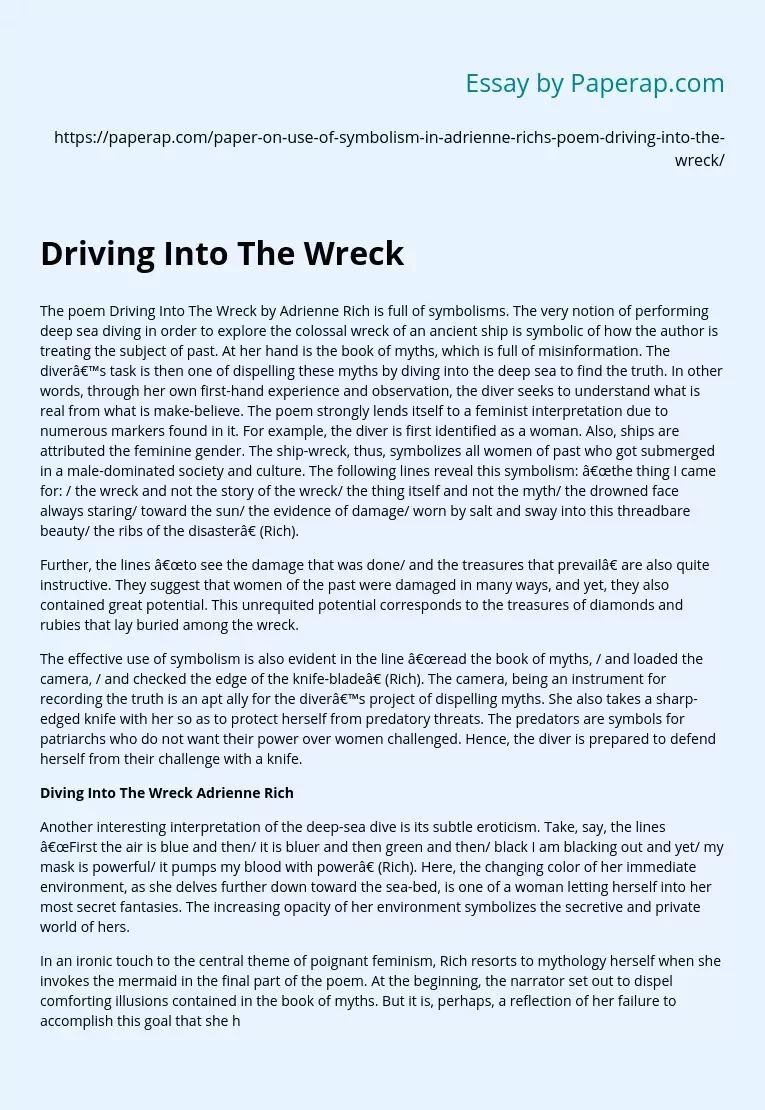The poem Driving Into The Wreck by Adrienne Rich is full of symbolisms. The very notion of performing deep sea diving in order to explore the colossal wreck of an ancient ship is symbolic of how the author is treating the subject of past. At her hand is the book of myths, which is full of misinformation. The diver’s task is then one of dispelling these myths by diving into the deep sea to find the truth. In other words, through her own first-hand experience and observation, the diver seeks to understand what is real from what is make-believe.
The poem strongly lends itself to a feminist interpretation due to numerous markers found in it. For example, the diver is first identified as a woman. Also, ships are attributed the feminine gender. The ship-wreck, thus, symbolizes all women of past who got submerged in a male-dominated society and culture. The following lines reveal this symbolism: “the thing I came for: / the wreck and not the story of the wreck/ the thing itself and not the myth/ the drowned face always staring/ toward the sun/ the evidence of damage/ worn by salt and sway into this threadbare beauty/ the ribs of the disaster” (Rich).
Further, the lines “to see the damage that was done/ and the treasures that prevail” are also quite instructive. They suggest that women of the past were damaged in many ways, and yet, they also contained great potential. This unrequited potential corresponds to the treasures of diamonds and rubies that lay buried among the wreck.
The effective use of symbolism is also evident in the line “read the book of myths, / and loaded the camera, / and checked the edge of the knife-blade” (Rich). The camera, being an instrument for recording the truth is an apt ally for the diver’s project of dispelling myths. She also takes a sharp-edged knife with her so as to protect herself from predatory threats. The predators are symbols for patriarchs who do not want their power over women challenged. Hence, the diver is prepared to defend herself from their challenge with a knife.
Diving Into The Wreck Adrienne Rich
Another interesting interpretation of the deep-sea dive is its subtle eroticism. Take, say, the lines “First the air is blue and then/ it is bluer and then green and then/ black I am blacking out and yet/ my mask is powerful/ it pumps my blood with power” (Rich). Here, the changing color of her immediate environment, as she delves further down toward the sea-bed, is one of a woman letting herself into her most secret fantasies. The increasing opacity of her environment symbolizes the secretive and private world of hers.
In an ironic touch to the central theme of poignant feminism, Rich resorts to mythology herself when she invokes the mermaid in the final part of the poem. At the beginning, the narrator set out to dispel comforting illusions contained in the book of myths. But it is, perhaps, a reflection of her failure to accomplish this goal that she herself imagines to be a mermaid and circling the ship wreck. This is not a weak submission but, rather, a graceful acceptance of reality. After all, even after a century of feminist revolt, modern society is still dominated by men. This is evident in all facets of life – from families to schools to business corporations.
In sum, the poem Diving Into The Wreck by Adrienne Rich is very imaginative and suffused with rich symbolisms. Most symbolisms are in reference to feminist thought and feminine experience and fantasy. Though the subject deals with emotions and a sense of remorse, the authorial tone is quite sober and understated.
Work Cited:
Rich, Adrienne. Diving into the Wreck. Web. 9th June, 2013. http://www.poets.org/viewmedia.php/prmMID/15228#sthash.2eMyKUNR.dpuf
In the first chapter titled ‘Is Belief Wishful Thinking?’ Herbert McCabe throws light on the evolution of faith. According to McCabe, one of the lazy pretexts for religious belief is its comforting illusions. People have a tendency to want to believe in a fair and wise God who dispenses justice to all. But this is nothing more than wishful thinking. Yet, the validity of religious belief does not stand negated just because some of the faithful indulge in wishful thinking. Unlike scientific facts, religious beliefs have two components – fact and interpretation. So a combination of literal truth and metaphoric suggestion is at play in the system of beliefs that comprise a religion. In Christianity for example, “beliefs do entail certain simple factual historical beliefs, and in their case it is certainly possible to show what scientific evidence would count against them.” (p.2) McCabe cites the resurrection of Christ as an example of a belief that can be scientifically .
Driving Into The Wreck. (2019, Dec 05). Retrieved from https://paperap.com/paper-on-use-of-symbolism-in-adrienne-richs-poem-driving-into-the-wreck/

